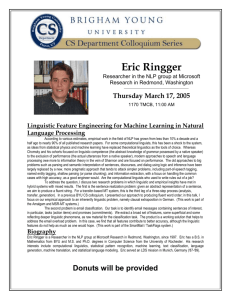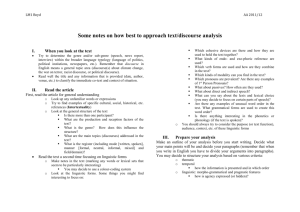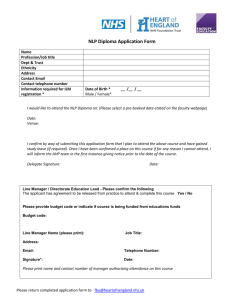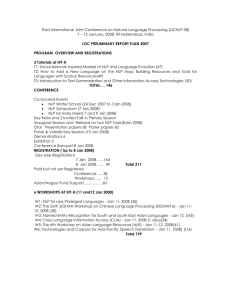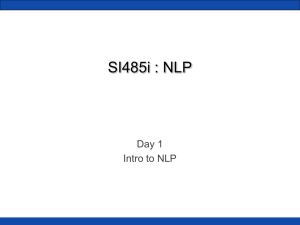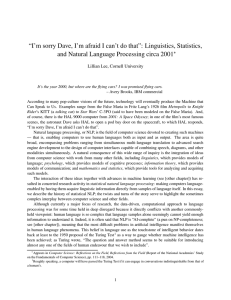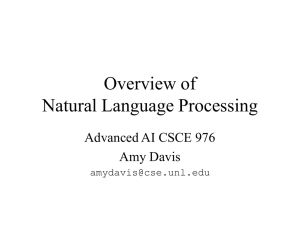Natural Language Processing
advertisement
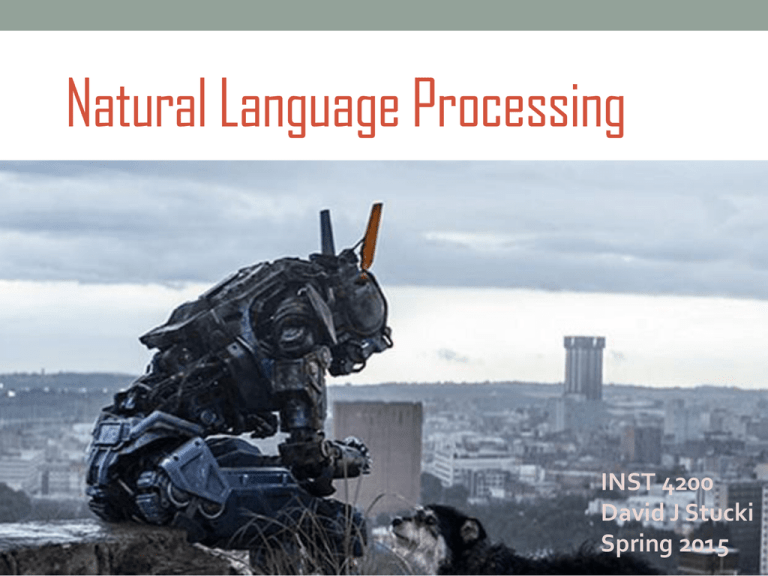
Natural Language Processing INST 4200 David J Stucki Spring 2015 Introduction to NLP • An Introduction to Natural Language Processing, Computational Linguistics, and Speech Recognition, by Daniel Jurafsky & James H. Martin • Consider (again) the HAL-9000 computer • HAL is an artificial agent capable of such advanced language processing behavior as speaking and understanding English, and at a crucial moment in the plot, even reading lips • The language-related parts of HAL • Speech recognition • Natural language understanding (and, of course, lip-reading), • Natural language generation • Speech synthesis • Information retrieval • Information extraction • Inference Introduction to NLP 3 Data Processing vs. Language Processing • By NLP, we have in mind those computational techniques that process spoken and written human language, as language. • What distinguishes these language processing applications from other data processing systems is their use of knowledge of language. • Computer programs: • When a program measures data by counting bytes or lines of text, it is an ordinary data processing application. • However, when it is used to count the words in a file it requires knowledge about what it means to be a word, and thus becomes a language processing system. • Example: Python Ghost-writer Introduction to NLP 4 Knowledge in Speech and Language Processing • Both the tasks of being capable of analyzing an incoming audio signal and recovering the exact sequence of words and generating its response require knowledge about phonetics and phonology, which can help model how words are pronounced in colloquial speech. • Producing and recognizing the variations of individual words (e.g., recognizing that doors is plural) requires knowledge about morphology, which captures information about the shape and behavior of words in context. Knowledge Problems • Syntax: the knowledge needed to order and group words together. • HAL, the pod bay door is open. • HAL, is the pod bay door open? • I’m I do, sorry that afraid Dave I’m can’t. • Lexical semantics: knowledge of the meanings of the component words • Compositional semantics: knowledge of how these components combine to form larger meanings • To know that Dave’s command is actually about opening the pod bay door, rather than an inquiry about the day’s lunch menu. • Pragmatics: the appropriate use of the kind of polite and indirect language Introduction to NLP 6 Linguistic Categories • Phonetics and Phonology — The study of linguistic sounds • Morphology —The study of the meaningful components of • • • • words Syntax —The study of the structural relationships between words Semantics — The study of meaning Pragmatics — The study of how language is used to accomplish goals Discourse—The study of linguistic units larger than a single utterance Introduction to NLP 7 Ambiguity • A perhaps surprising fact about the six categories of linguistic knowledge is that most or all tasks in speech and language processing can be viewed as resolving ambiguity at one of these levels. • We say some input is ambiguous • if there are multiple alternative linguistic structures than can be built for it. • The spoken sentence, I made her duck, has five different meanings. (1) I cooked waterfowl for her. (2) I cooked waterfowl belonging to her. (3) I created the (plaster?) duck she owns. (4) I caused her to quickly lower her head or body. (5) I waved my magic wand and turned her into undifferentiated waterfowl. Approaches • Canned discourse (think Chinese Room…) • Template systems: fill in blanks in pre-made sentence schemas • Systemic Grammars • Representation of sentences as collections of functions. Rules allow mapping from functions to grammatical forms. (Halliday, 1985) • Comes from a branch of linguistics called Systemic-Functional Linguistics • Functional Unification Grammars • Represents sentences as feature structures that can be combined and altered to produce sentences. (Kay, 1979) NLG Choice Issues Architecture Communicative Goal Knowledge Base Discourse Structure Discourse Planner Context Selection Mechanisms for building Discourse Structures: - Text schemata; Rhetorical Relations Content Selection Lexical Selection Output from DP Microplanning Sentence Structure Input to SR -referring expressions -aggregation Surface Realizer Approaches: - Systemic Grammar; - Functional Unification Grammar Natural Language Output Systemic Grammar • Mood Layer (interpersonal meta-function) • Describes the interaction between the sentence writer and reader • Transitivity Layer (ideational meta-function) • Identifies items such as who the actors are and what the goals are for the sentence • Identifies the type of process being performed • Theme Layer (textual meta-function) • Tries to fit the expression with a given theme and reference Figure 20-2 From “”Speech and Language Processing”, Daniel Jurafsky & James H. Martin, Prentice Hall, 2000. The concept of dialect Dialects used by different speech communities Language The concept of register Registers: Uses of language in different contexts Language



